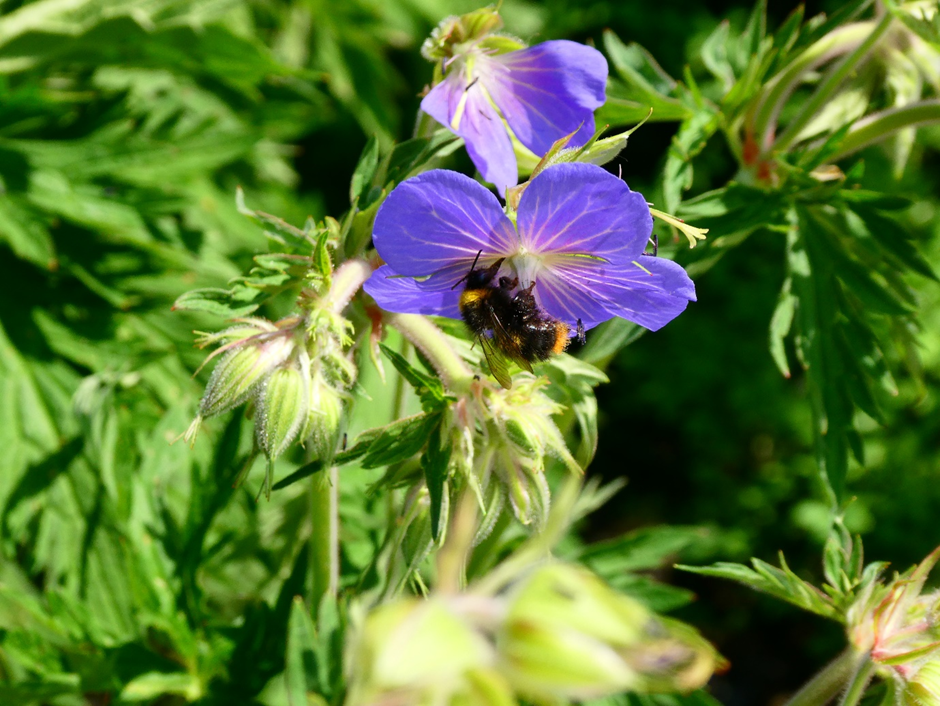Richard Jefferson and colleagues highlight some fascinating aspects of the ecology and conservation of meadow crane’s-bill in their recently published Biological Flora of Britain and Ireland: Geranium pratense:
Introduction
The striking blue-violet flowers of meadow crane’s-bill decorate road verges, hedge borders, woodland rides and riverbanks in Britain & Ireland during June, July and August.


As can be seem from the previous list of habitats, ‘meadow’ is a misnomer as it rarely occurs in meadows and pastures that have a period of livestock grazing due to the plant’s general intolerance of this practice.
Its attractiveness is one reason why it has been much cultivated for ornament around the world. The Royal Horticultural Society Plant finder (2023) for example, lists 55 cultivars of G. pratense for sale.
The roots and aerial parts of meadow crane’s-bill are used in traditional medicine in Asia to treat a range of complaints including fever, coughs, jaundice and stomach disorders. It contains an essential oil (geraniol) that has anti-microbial properties and can inhibit tumour growth.
But beyond the simple aesthetics of the flowers and its medicinal properties, meadow crane’s-bill has several fascinating aspects to its ecology.
It is gynodioecious meaning that the flowers of individual plants may be either wholly female or hermaphrodite. In our account, we also note that individuals may either be gynomonoecious, i.e., have both female and hermaphrodite flowers, or hermaphroditic.
Meadow crane’s-bill is insect-pollinated and accordingly is visited by a wide range of insects to source nectar and pollen – bees, hoverflies, beetles, moths and butterflies. In our Biological Flora, we list 46 species – 25 bees, 6 hoverflies and 15 butterflies but this total may be far from exhaustive. The copious amounts of nectar and pollen produced by the plant has led to it being considered an important ‘honey plant’ and a ‘bee bread plant’ in Russia. Bee bread is a mixture of pollen and nectar or honey and is the main source of food for honeybee workers and larvae.
Inspection of the flowers and leaves in summer may also reveal the presence of a small black weevil. This is the geranium weevil, Zacladus geranii, the adults and larvae of which feed on larger Geranium species. It is widespread in England but scarce in Wales and Scotland and absent from Ireland.

Conservation, status and future threats
Although speculative, we suggest that the original main habitat for meadow cranesbill may have been species-rich tall herb vegetation known on the continent as saum or forest fringe vegetation which has now disappeared from the lowland landscape. Subsequently meadow crane’s-bill hasbeen able to exploit similar anthropogenic habitats such as road verges.
The most recent survey of the flora of Britain & Ireland showed that meadow crane’s-bill is a fairly widespread plant in Great Britain occurring in 48% of the 10km squares but this falls to 35% when alien sites are discounted. It is, though, very rare as a native plant in Ireland. In addition, the Plant Atlas found that the long-term trend in occurrence for the period 1930 – 2019 was stable but the short-term trend for the period 1987 – 2019 was stable to increasing. The latter trend is due to range expansion largely because of introductions from wildflower seed-sowing and spread from gardens. Meadow crane’s-bill seed is widely available as a single species or as a component of wildflower seed mixes.
We reviewed whether there were likely to be any impacts to native populations from introductions into the ‘wild’ of plants from seed mixes or those of garden origin. Possible harmful effects include hybridisation between alien and local genotypes leading to outbreeding depression1 and subsequent lower fitness of progenitors2 and the risk that alien genotypes may become invasive if superior to local ecotypes. Although the evidence base is limited, we consider that at present, there is not a strong case for genetic rescue3.
The most recent climate change predictions for the next 50 years, published by the Met Office predict a move towards warmer, wetter winters and hotter, drier summers. G. pratense has a wide latitudinal distribution in the Temperate and Boreal zones and, assessment of its ‘climate space’, suggest that its range, distribution and abundance in Britain and Ireland may not be radically changed under the above scenarios.
Overall, we conclude that at present there is no immediate threat to sustaining the distribution and abundance of meadow crane’s-bill in Britain and Ireland.
Read the full account online: Biological Flora of Britain & Ireland: Geranium pratense.
For a full list of Biological Flora, take a look at the database.
Footnotes:
1 Outbreeding depression occurs when crosses between genetically distant populations leads to a reduction in fitness
2 The direct antecedent of an individual in a direct line of descent
3 Genetic rescue is a technique to restore population genetic diversity and resilience and reduce extinction risks to plant populations e.g., by translocation of individuals


